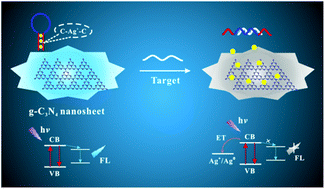A novel label-free strategy for pathogenic DNA detection based on metal ion binding-induced fluorescence quenching of graphitic carbon nitride nanosheets†
Abstract
Graphitic carbon nitride (g-C3N4) nanosheets are a type of two-dimensional nanomaterial with stable photoluminescence and large specific surface areas that make them an ideal candidate for fluorescence sensing. However, fluorescence sensing based on g-C3N4 nanosheets for disease-specific biomolecules is still limited. Moreover, current g-C3N4 nanosheet-based fluorescence sensors for nucleic acid require pre-labeling which is time-consuming and cost-ineffective. In this work, a novel label-free strategy for HBV gene determination based on metal ion binding-induced fluorescence quenching of g-C3N4 nanosheets was designed. Under the optimized conditions, this bioassay provided high sensitivity for HBV gene determination with the limit of detection as low as 1.0 nM, and has been successfully applied for the detection of HBV gene in human serum with satisfactory results. By embedding different recognition sequences of the probes, this method may be conveniently used for versatile detection of diverse disease markers. This novel design may provide a simple, flexible, sensitive and low-cost strategy for g-C3N4 nanosheet-based disease-specific biomolecule sensing.



 Please wait while we load your content...
Please wait while we load your content...